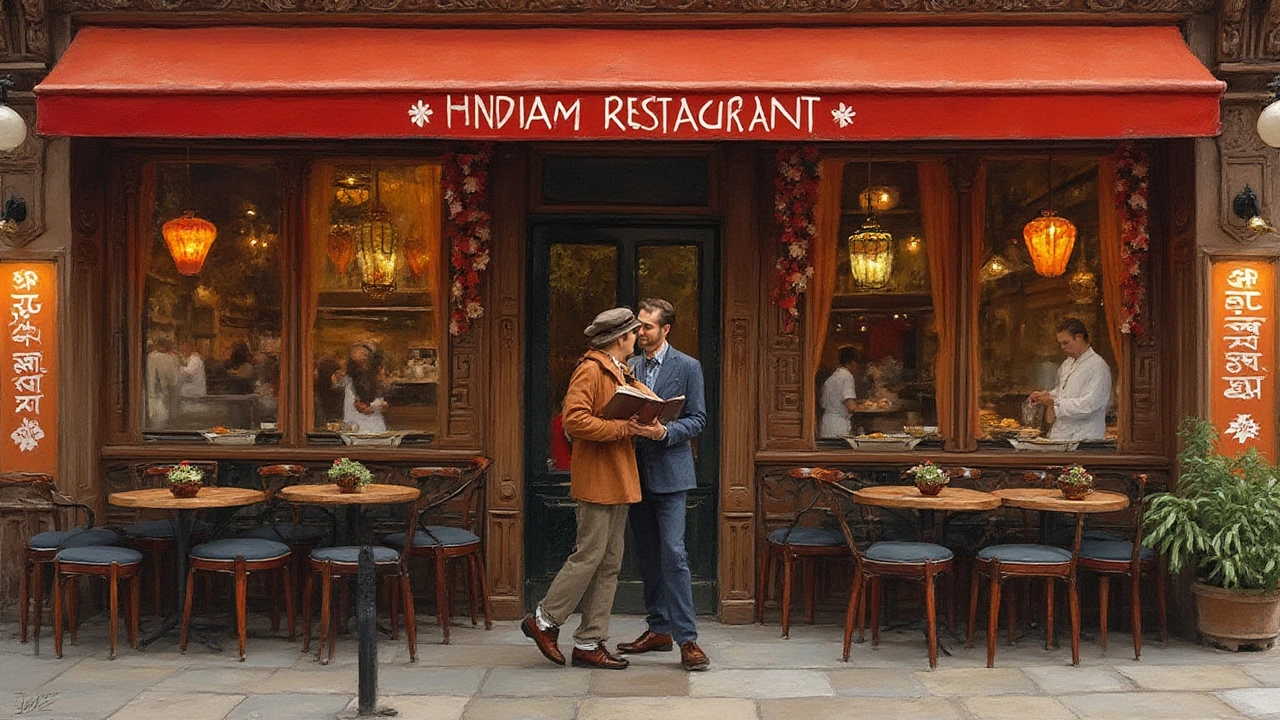If you're still thinking a proper Indian restaurant is just chicken tikka masala and naan, you might be missing out on some of the best flavors London has to offer. Chasing the best Indian restaurant isn't about picking the busiest spot in Soho or the flashiest curry house on Brick Lane. What if the true gems are tucked between off-licenses, hiding in plain sight? London’s Indian food scene is a labyrinth: centuries-old recipes mingle with café experimentations, home kitchens blossom into eateries, and family-run places simmer with stories. What’s their secret? Let’s break it down, so next time you fancy a curry, you skip the generic and discover something mind-blowing.
Best Indian Restaurant – How to Find the Real Hidden Gems: Your Comprehensive Guide
When people say "best Indian restaurant," what do they really mean? Is it the place with the longest line, or the one where the chef won’t reveal his grandmother’s garam masala blend? For most food obsessives, the hunt for Indian restaurant gems starts with a craving for intense flavors, unapologetic heat, and dishes you don’t see everywhere. The journey covers more than food—it’s about regional authenticity, warmth in service, and cultural connections. Here’s what we’re covering: the background and rise of Indian food in London, the blueprint for a real hidden gem, how to spot the good from the mediocre, what benefits you’ll reap (hint: there’s more to it than deliciousness), what to expect from your adventure, steps for finding and experiencing these restaurants, plus a FAQ for your burning questions—curry-related and otherwise.
Understanding the Basics of the Best Indian Restaurant
Origins and History
Indian food came to Britain with the earliest traders and immigrants, but it truly bloomed in the last 60 years. The first curry house on record opened in 1810—that’s before the Victorian era! But things really took off post-World War II, when Bengali and Punjabi families built canteens for their own communities; these slowly became restaurants for everyone. What’s wild is how "Indian" restaurants were just as likely to be run by Bangladeshis or Pakistanis as they were by Indians. Yet, the passion remains: recipes passed down through generations, with each cook adding a twist for local taste or sticking to tradition. In modern London, you’ll find Kashmiri rogan josh next to a Mumbai street food stall, or a Goan fish curry down the street from an old-school North Indian grill.
Core Principles or Components
The making of a great Indian restaurant boils down to a few key things: regional authenticity—not just generic "curry," but specific states or even villages; honest spicing (meaning fresh ground, not just bulk powders); and passion that you can taste in the food, sense in the service, or even spot in hand-written menus. Proper thalis (those beautiful platters of little dishes) offer a glimpse into real Indian home eating, while sizzling tandoori shows off clay-oven mastery that sets good joints apart. A gem restaurant often refuses shortcuts: they grind their own pastes, marinate meat overnight, and won’t water down their food for Western palates (unless you ask).
How It Differs from Related Practices
| Type | Key Feature | Primary Benefit |
|---|---|---|
| Best Indian Restaurant | Authentic recipes, regional focus, family-run | Unique flavors, traditional experience |
| Generic Curry House | Standardised menu, mild spices, fast food | Consistent, but often bland |
| Modern Indian Fusion | Eclectic flavors, Western twists | Fun creativity, unexpected pairings |
A real Indian gem won’t shy away from dishes you’ve never heard of—look for dhansak (a Parsi stew), chettinad chicken, or Indo-Chinese gobi manchurian. The best places don’t overpromise: they let their flavors speak.
Who Can Benefit from Best Indian Restaurant?
Basically, anyone with an adventurous palate, or whose heart beats faster at the smell of toasted cumin, is in the right place. Foodies, travelers yearning for a taste of home, families after comfort food, even gluten-free eaters who want naturally wheat-less dosas—the range is vast. Many spots cater to vegan, veggie, and halal preferences, because diversity is at the very heart of Indian cuisine. Gem restaurants invite you to eat with your hands, share plates, ask questions, and discover dishes that never make it into mass-market menus. Trying a new restaurant might even spark memories from childhood meals—or start a craving for something completely new.
Benefits of the Best Indian Restaurant Experience
Unique Flavors and Depth
Forget the generic—I’m talking about fiery vindaloo that’s actually hot, fragrant biryanis cooked with whole spices, and chutneys that make your tongue do a happy dance. Proper Indian restaurants surprise you: one bite might be smoky, the next tart or sweet. Research into food culture (see resources from BBC Food Web source (https://www.bbc.co.uk/food/cuisines/indian) and The British Library Web source (https://www.bl.uk/learning/cult/inside/indianfood/indianfood.html)) shows that variety is built into the cuisine, reflecting massive diversity in India itself. You’ll taste mustard oil from Bengal, coconut in the southwest, or black cardamom from the north. These places remind you: authentic food comes from respecting the source.
Value for Money and Nourishment
Here’s the best part: many real Indian gems keep things affordable. Home-style recipes, shared platters, and generous portions mean you can fill up without draining your wallet. Fresh pulses, seasonal veg, and lean proteins don’t just taste good—they’re good for you. Dishes at authentic places often use less oil and more natural spices, and they rarely drown ingredients in heavy cream or butter unless it’s traditional. It’s mind-blowing how satisfying something like daal tadka can be, especially when you know it’s been simmered for hours.
Cultural Connection and Community
This isn’t just dinner—it’s a cultural trip. Restaurants run by families often celebrate festivals, play Bollywood hits, or tell you the background of their best dishes if you ask. Some spots double as community centers. Sharing a thali or mopping up curry with a paratha is experience as much as nourishment—you can feel that you’re not just a customer but a welcomed guest. The human side of food is always centre stage here.
Practical Outcomes
| Benefit | Description | Impact |
|---|---|---|
| Flavor Exploration | New tastes and textures | Breaks food monotony |
| Healthy Options | Lentils, spices, grilled meats | Nourishing, often lower in fat |
| Social Cohesion | Shared dishes, family atmosphere | Encourages bonding |
| Discovery | Learning about Indian culture | Expands worldview |
For anyone tired of bland weekday takeaways, a good Indian gem can reinvent dinner, spark conversation, and fill you with more than just food.
What to Expect When Engaging with the Best Indian Restaurants
Setting or Context
One thing you’ll notice with hidden gems: atmosphere matters. Forget white tablecloths or glitzy signs—these places might be snug, bustling spaces bursting with chatter and the aroma of cardamom. You could find yourself perched on a stool, tucking into samosas under fluorescent lights, or sitting in a cozy booth staring at framed family photos. Often, the menu is scrawled on a blackboard, and if you’re lucky, someone’s aunty is stirring a pot in the visible kitchen. That homely touch is what makes these places so inviting.
Key Processes or Steps
Start by scanning the menu for unfamiliar dishes—you’ll know you’re somewhere good if you have to Google a few names. Ask your server about their specialities or what’s most popular with locals, not tourists. Many spots recommend sharing, so go with a group if you can. Food usually arrives family-style: big bowls to scoop onto your plate, hot naan, and plenty of sauces. Don’t rush—half the joy is watching steam rise from the curries and digging into sides like raita or achar (pickles). Dessert? Gulab jamun or ras malai to finish things sweetly.
Customization Options
Authentic doesn’t mean rigid. Many Indian restaurants can adjust spice levels or swap in different veg or protein. Got allergy concerns? Just ask—a proper place will happily explain ingredients or offer off-menu tweaks. A vegan might get an entire feast of lentil curry and coconut veg, while carnivores can dig into kebabs straight from the tandoor. And if you crave something classic like butter chicken, you can ask how the chef makes it unique.
Communication and Preparation
Don’t be shy—conversation is your best tool. Staff at these gems often love explaining the story behind dishes or suggesting pairings. Prep by skimming some regional food guides, noting any "must try" in the local foodie press, and booking ahead (many gems are tiny and fill up fast). Got a special dietary need? A quick phone call goes a long way. And always ask about daily specials—they’re where the chef gets creative or nostalgic.
How to Practice or Apply Finding Your Indian Gem
Setting Up for Success
Leave your preconceptions at home and be ready to explore. Use tools like food blogs, local Instagram accounts, and good old-fashioned word-of-mouth—often, cab drivers or shopkeepers know the real stars. Read reviews with a grain of salt; sometimes, lower ratings mean the flavors weren’t soft-pedalled for casual diners. Try food festivals or pop-ups to discover future favorites as well.
Choosing the Right Tools and Resources
Grab a trusted map app marked with reviews, but don’t stop there. Sites like Time Out or The Infatuation offer lists, but “best of” doesn’t always mean the most authentic. For deeper dives, explore forums like Reddit’s r/London or r/IndianFood, or Foodie Facebook groups. Apps like Google Maps, Zomato, or TripAdvisor can be useful, but trust personal recommendations. And don’t underestimate the value of conversations with staff at Asian supermarkets or spice shops nearby—they usually have insider knowledge.
Step-by-Step Guide
- Pinpoint a few likely gems using food forums, local blogs, and chats with friends.
- Check opening times and see if you need to book ahead (many are closed on Mondays or midweek for religious reasons).
- Bring cash; some hidden gems don’t take cards.
- Go in a small group to maximise dish sharing.
- Start with an open mind—order the house special and something unfamiliar.
- Ask questions and share feedback with the chef or waitstaff—many appreciate it.
- Take leftovers home, if offered—the best curries taste even better the next day.
Tips for Beginners or Couples
If it’s your first time, don’t worry about butchering the names. Smile, point at the menu, and ask what’s good. For couples, a shared thali or a line-up of small plates is romantic and practical. Beginners should try a starter (like bhel puri), share a main, and sample at least one bread or rice. It’s a bit like a treasure hunt—sometimes you strike gold, sometimes you get a lesson for next time. Take notes for yourself so you can remember those unexpected hits!

FAQ: Common Questions About Best Indian Restaurants
What should I expect from a truly authentic Indian restaurant?
Expect lots of sharing, a menu with dishes from outside the usual curry house line-up, and food that speaks of the chef's roots. The setting might be cozy or bustling, with a mix of spicy aromas and diner chatter. Don't expect luxury—do expect warmth, attention to detail, and an experience that’s more like eating at a friend's family table than a chain restaurant.
What is the typical flow of a meal at a hidden gem Indian restaurant?
It begins with choosing a few small plates or street food starters, then moves to heartier mains (curries, grilled meats, rice and breads), and ends with sweets or a milky chai. Service is relaxed; dishes arrive when ready. Most places encourage slow eating and conversation, so there’s rarely any rush between courses. You’ll likely leave full—and possibly plotting your next visit.
How do hidden gem Indian restaurants differ from high-street curry houses?
Hidden gems focus on authenticity, use family recipes, and often feature regional specialties not typically seen on mainstream menus. High-street curry houses tend to offer standardised recipes, mild spice profiles, and Anglo-Indian twists. The difference lies in attention to regional tradition, creativity, and the personal touch of the owners or chefs.
What’s the standard method for preparing dishes at the best Indian restaurants?
Chefs at these gems usually prepare sauces and spice blends from scratch daily, marinate proteins for hours, and refuse to cut corners with pre-made mixes. They focus on layering flavors—often starting with toasting whole spices, then building gravies over low heat. The best places pride themselves on their tandoor (clay oven) skills and hand-rolled bread, ensuring each meal feels unique and soulful.
Safety and Ethical Considerations
Choosing Qualified Spots
Look for places with clean ratings from the Food Standards Agency, friendly service, and visible kitchens if you can. Family-run spots with a long history or awards from community groups are often a safe bet. Don’t be afraid to ask about the chef’s training or the origin of dishes—it’s a mark of pride for honest places to be transparent.
Safety Practices
| Practice | Purpose | Example |
|---|---|---|
| Food Hygiene | Safe, clean preparation | Staff wear gloves, open kitchen, visible cleaning |
| Allergen Info | Protects sensitive eaters | Ask about nuts, dairy, gluten |
| Transparency | Builds trust with customers | Menu lists main ingredients |
Always check for up-to-date hygiene certificates. If something seems unsanitary—or service is rude or evasive—it’s a sign to dine elsewhere.
Setting Boundaries
If you’re new or have dietary concerns, say so! It’s normal to ask for low-spice, no-dairy, or child-friendly dishes. The best restaurants are happy to cater, as long as you’re respectful and clear. If you’re unsure what’s in a dish, ask before ordering, and double-check if you have allergies or intolerances.
Contraindications or Risks
Peppery dishes and spicy chutneys aren’t for everyone. If you’re sensitive to spice, have stomach issues, or particular allergies, discuss these right away. If you’re immunocompromised or pregnant, avoid raw chutneys or salads. And when in doubt, consult your physician. Everyone’s body and palate are different—so listen to yours!
Enhancing Your Experience
Adding Complementary Practices
Try matching your meal with Indian side hobbies: listen to classic Bollywood playlists, bring friends along, or even watch a documentary about Indian cooking before your visit. Dishes like fermented dosas and tangy pickles offer gut health perks. For a fun twist, try your hand at making chai at home after your meal—or recreate a favorite dish you discovered.
Collaborative or Solo Engagement
These spots are perfect for group outings: order a load of different dishes and share around the table. Solo diners get the benefit of staff attention—often you’ll leave with bonus sides or advice about the next meal to try. No pressure either way; just eat at your own pace and enjoy the buzz.
Using Tools or Props
Keen to level up? Take along a regional Indian food guide, pack some wet wipes (curries can get messy!), and bring your appetite. Ask staff about the best way to eat a dish—some are meant to be scooped up by bread, others poured over rice. No need for posh cutlery here—fingers are often best.
Regular Engagement for Benefits
Making hidden gem visits part of your routine helps keep your culinary world fresh. Try visiting a new spot each month, or make an occasion of birthdays and celebrations. Consistency brings new discoveries, keeps local businesses thriving, and builds lasting fondness for the cuisine.
Finding Resources or Experts
Researching Qualified Experts
Look for mentions in respected local magazines, listings from The Good Food Guide, or recommendations from London foodie awards. A spot loved by chefs is often a safe bet. Double-check on forums for up-to-date reviews, since ownership and quality can change fast in the restaurant world.
Online Guides and Communities
Plug into food lover forums like r/IndianFood, community Facebook groups, or London-specific subreddits for the freshest tips. Watch video tours on YouTube to get a vibe for places before visiting. And don’t forget Instagram; chefs and restaurants often share daily specials and behind-the-scenes peeks.
Legal or Cultural Considerations
London’s diverse scene is open to all, but some restaurants observe religious holidays—so expect closures around Diwali, Eid, or Ramadan. Ask before bringing alcohol; some spots are BYOB (bring your own bottle), while others serve none at all due to religious or cultural reasons.
Resources for Continued Learning
Dive into books like Madhur Jaffrey’s cookbooks or the writings of Meera Sodha for more history and recipes. YouTube channels like Binging with Babish or Indian Home Cooking show step-by-steps. Local workshops or supper clubs (like those run by Spice Monkey or London School of Vegetarian Cooking) let you dig into the craft hands-on.
Why London’s Best Indian Restaurants Are Worth the Quest
A Path to Culture (and Incredible Flavor)
This isn’t just food—it’s a cultural adventure, a lesson in regional pride, and an invitation to belong. You’re not just hunting dinner; you’re joining a global community that loves big flavors, big hearts, and bold stories. Let your curiosity guide you and you’ll find places—and plates—you never expected.
Try It Mindfully
Ready to join the hunt? Go in curious, keep your mind open, and take someone along for the ride. Ask questions, savor your food, and if you have questions about health or ingredients, check with the restaurant or your GP. Magic happens when you say yes to something new.
Share Your Journey
Discovered a new favorite dish? Or found a spot that deserves more love? Tell your mates, leave a review, or drop a line in the comments. Your food journey helps these family-run gems survive—and keeps the adventure going for everyone else!
Some links may be affiliate links, but all recommendations are based on research and quality.







